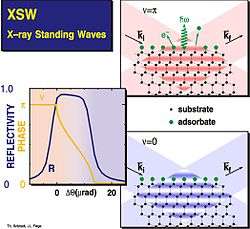X-ray standing waves
The X-ray standing wave (XSW) technique can be used to study the structure of surfaces and interfaces with high spatial resolution and chemical selectivity. Pioneered by B.W. Batterman in the 1960s,[1] the availability of synchrotron light has stimulated the application of this interferometric technique to a wide range of problems in surface science.[2][3]
Basic principles

An X-ray standing wave (XSW) field is created by interference between an X-ray beam impinging on a sample and a reflected beam. The reflection may be generated at the Bragg condition for a crystal lattice or an engineered multilayer superlattice; in these cases, the period of the XSW equals the periodicity of the reflecting planes. X-ray reflectivity from a mirror surface at small incidence angles may also be used to generate long-period XSWs.[4]
The spatial modulation of the XSW field, described by the dynamical theory of X-ray diffraction, undergoes a pronounced change when the sample is scanned through the Bragg condition. Due to a relative phase variation between the incoming and reflected beams, the nodal planes of the XSW field shift by half the XSW period.[5] Depending on the position of the atoms within this wave field, the measured element-specific absorption of X-rays varies in a characteristic way. Therefore, measurement of the absorption (via X-ray fluorescence or photoelectron yield) can reveal the position of the atoms relative to the reflecting planes. The absorbing atoms can be thought of as "detecting" the phase of the XSW; thus, this method overcomes the phase problem of X-ray crystallography.
For quantitative analysis, the normalized fluorescence or photoelectron yield is described by [2][3]
,
where is the reflectivity and is the relative phase of the interfering beams. The characteristic shape of can be used to derive precise structural information about the surface atoms because the two parameters (coherent fraction) and (coherent position) are directly related to the Fourier representation of the atomic distribution function. Therefore, with a sufficiently large number of Fourier components being measured, XSW data can be used to establish the distribution of the different atoms in the unit cell (XSW imaging).[6]

Experimental considerations
XSW measurements of single crystal surfaces are performed on a diffractometer. The crystal is rocked through a Bragg diffraction condition, and the reflectivity and XSW yield are simultaneously measured. XSW yield is usually detected as X-ray fluorescence (XRF). XRF detection enables in situ measurements of interfaces between a surface and gas or liquid environments, since hard X-rays can penetrate these media. While XRF gives an element-specific XSW yield, it is not sensitive to the chemical state of the absorbing atom. Chemical state sensitivity is achieved using photoelectron detection, which requires ultra-high vacuum instrumentation.
Measurements of atomic positions at or near single crystal surfaces require substrates of very high crystal quality. The intrinsic width of a Bragg reflection, as calculated by dynamical diffraction theory, is extremely small (on the order of 0.001° under conventional X-ray diffraction conditions). Crystal defects such as mosaicity can substantially broaden the measured reflectivity, which obscures the modulations in the XSW yield needed to locate the absorbing atom. For defect-rich substrates such as metal single crystals, a normal-incidence or back-reflection geometry is used. In this geometry, the intrinsic width of the Bragg reflection is maximized. Instead of rocking the crystal in space, the energy of the incident beam is tuned through the Bragg condition. Since this geometry requires soft incident X-rays, this geometry typically uses XPS detection of the XSW yield.
Selected applications
Applications which require ultra-high vacuum conditions:
- Physisorption and chemisorption studies [2][3]
- Diffusion of dopants in crystals [7]
- Superlattices and Quasi-crystal characterization
Applications which do not require ultra-high vacuum conditions:
- Langmuir-Blodgett films
- Self-assembled monolayers
- Model heterogeneous catalysts[8]
- Buried interfaces
See also
- List of surface analysis methods
References
- B. W. Batterman and H. Cole (1964). "Dynamical Diffraction of X Rays by Perfect Crystals". Reviews of Modern Physics. 36 (3): 681. doi:10.1103/RevModPhys.36.681.
- J. Zegenhagen (1993). "Surface structure determination with X-ray standing waves". Surface Science Reports. 18 (7/8): 202–271. doi:10.1016/0167-5729(93)90025-K.
- D. P. Woodruff (2005). "Surface structure determination using x-ray standing waves". Reports on Progress in Physics. 68 (4): 743. doi:10.1088/0034-4885/68/4/R01.
- M.J. Bedzyk, G.M. Bommarito, J.S. Schildkraut (1989). "X-ray standing waves at a reflecting mirror surface". Physical Review Letters. 62 (12): 1376–1379. doi:10.1103/PhysRevLett.62.1376. PMID 10039658.CS1 maint: multiple names: authors list (link)
- J. Als-Nielsen and D. McMorrow (2001). Elements of Modern X-ray Physics. John Wiley & Sons, Ltd. ISBN 978-0471498582.
- L. Cheng, P. Fenter, M. J. Bedzyk, and N. J. Sturchio (2003). "Fourier-Expansion Solution of Atom Distributions in a Crystal Using X-Ray Standing Waves". Physical Review Letters. 90 (25): 255503. doi:10.1103/PhysRevLett.90.255503. PMID 12857143.CS1 maint: multiple names: authors list (link)
- P. Hoenicke; et al. (2010). "Depth profile characterization of ultra shallow junction implants". Analytical and Bioanalytical Chemistry. 396 (8): 2825–32. doi:10.1007/s00216-009-3266-y. PMID 19941133.
- Z. Feng, C.-Y. Kim, J.W. Elam, Q. Ma, Z. Zhang, M.J. Bedzyk (2009). "Direct Atomic-Scale Observation of Redox-Induced Cation Dynamics in an Oxide-Supported Monolayer Catalyst: WOx/α-Fe2O3(0001)". Journal of the American Chemical Society. 131 (51): 18200–18201. doi:10.1021/ja906816y. PMID 20028144.CS1 maint: multiple names: authors list (link)
Further reading
Zegenhagen, Jörg; Kazimirov, Alexander (2013). The X-Ray Standing Wave Technique. World Scientific. doi:10.1142/6666. ISBN 978-981-2779-00-7.